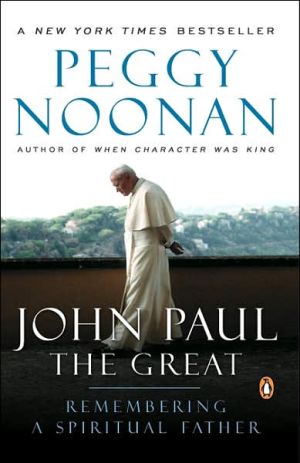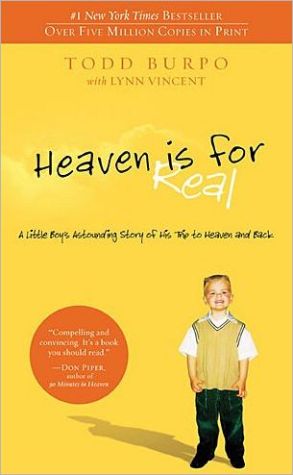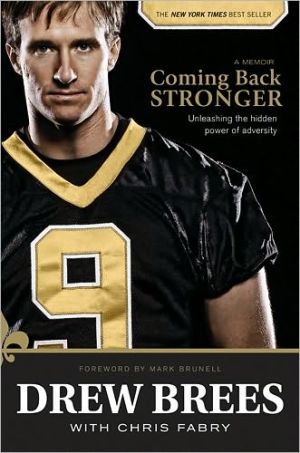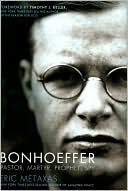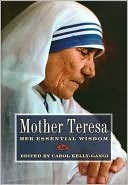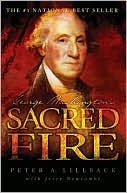John Paul the Great: Remembering a Spiritual Father
From New York Times bestselling author Peggy Noonan comes "a beautifully written testimony about . . . the most historically recognized pope" (Library Journal)\ With such accla imed books as When Character Was King, Peggy Noonan has become one of our most eloquent and respected commentators. Now she offers a stirring portrait of a spiritual and intellectual giant who personally confronted all of the worst tragedies of his age. Drawing on scholarship, interviews with prominent Catholics, and...
Search in google:
From New York Times bestselling author Peggy Noonan comes "a beautifully written testimony about . . . the most historically recognized pope" (Library Journal) With such accla imed books as When Character Was King, Peggy Noonan has become one of our most eloquent and respected commentators. Now she offers a stirring portrait of a spiritual and intellectual giant who personally confronted all of the worst tragedies of his age. Drawing on scholarship, interviews with prominent Catholics, and her own experience, Noonan traces the extraordinary life and struggles of Pope John Paul II with characteristic insight and probity-and explores how much we can learn from his leadership, diplomacy, humility, and holiness. Passionate and often deeply personal, John Paul the Great is as exceptional as the man it celebrates. Library Journal Noonan delivers a paean to John Paul II in 15 chapters that cover him from his childhood in wartime Poland through his final years as one of the most beloved popes in history. She met him in the summer of 2003, when it was apparent the frail, ailing man was near the end of his term. Noonan speaks adoringly of John Paul, his humility, everyday mysticism, and love and understanding of people. Only a couple of major flaws are attributed to him: the acceptance of the New Revised Standard Bible in the late 1980s, which created a "flattening and dulling of the scriptures," and the sex scandals that plagued the Catholic Church during the last decade of the 20th century, whereby over 1200 priests in America were charged with sex abuse and over $400 million paid in damages. The program concludes with a chapter on the new pope, Benedict XVI, and Noonan's hopes and expectations for his leadership. The author does an enthusiastic reading of her material, at times almost speaking directly to the listener rather than reading from a text. Recommended for all libraries.-Deb West, Gannon Univ. Lib., Erie, PA Copyright 2006 Reed Business Information.
John Paul the Great\ \ By Peggy Noonan \ Viking Adult\ ISBN: 0-670-03748-6 \ \ \ Chapter One\ I Saw a Saint at Sunset \ It was early morning in the Vatican, July 2, 2003, a brilliant morning in the middle of the worst Roman heat wave in a century. The city was quiet, the streets soft with the heat. It was the summer of the dress code battle between the tourists and the guards at St. Peter's Basilica. The tourists wanted to wear shorts and halter tops; this was in violation of the Vatican dress code (slacks, shirts with sleeves), and the guards wouldn't let them in. There were arguments at the entrance, and angry words. Soon a Roman compromise was achieved: No one lost face; everyone got what they needed. The vendors in St. Peter's Square were allowed to sell paper shirts and pants for a euro apiece. The tourists would put them on over their clothes, walk past the guards, and tear the paper off as they entered the dark cool of the church.\ By 7:45 a.m., hundreds of us had gathered in the Piazza del Sant'Uffizio, in the shadow of Bernini's colonnade, the marble columns that curve outward to embrace St. Peter's Square. Already the heat was gathering, and we fanned ourselves with thin green papal audience tickets. The crowd was happy-chirping nuns, clicking tourists. We were about to see the pope. We were about to see John Paul.\ We are a mix of tourists, the curious, and the faithful: a group of deaf Italian adults in white baseball caps, with silk Vatican flags tied around their necks; members of a choir from the Archdiocese of St. Louis, Missouri; a group of nuns from the Little Mission for the Deaf in Bologna. There was a man from Monterey, Mexico, with his wife and two children. As the crowd grew, we were pressed so close I could smell the spray starch on his green cotton shirt.\ "Why are you here?" I asked.\ "To see the pope," he said. "He is the most important Christian in the world. He is the follower of Christ." When, a few minutes later, I read the quote back to him from my notebook, he edited it. "He is the most important person in the whole world."\ I talked to a woman in a hat made of hay. Spiky yellow straw, actually, the brim down to shade her face. She was forty-five or fifty years old and looked like pictures of the older, weathered Greta Garbo. She told me she was on a pilgrimage. She had walked hundreds of kilometers in a circuitous tour of Marian sites. She and her husband-bearish, gray bearded-had departed upper Austria in May and had arrived here yesterday, on July 1st. They had walked on highways and small roads. She showed me her diary of the pilgrimage: In neat precise script she had documented every church they had seen along the way. Her husband had drawn pictures of cathedrals in blue ballpoint ink. He had taken snapshots of little chapels and pasted them in the diary. "Here," she said to me, indicating a page on which she had made comic line drawings. They showed angular feet bruised by exaggerated calluses. Next to them she had drawn the lotions and bandages she had put upon her wounds. They had gone to mass every day of their six-week journey, she said.\ Why had they come here?\ "Why? To see Il Papa!" She gestured as if to say: This is the culmination.\ We filed through metal detectors that did not seem to work, no beeping or bopping, no one watching things closely. It is surprising to see metal detectors here, for a crowd like this, but the last time someone planned to kill the pope, in the Philippines, the would-be assassin meant to dress as a priest. Soon we were directed through a paved area just off St. Peter's Square. (Later, when I would return to it, a young priest would tell me, "We think he may have been crucified under here." I shook my head. "Saint Peter. It may have been just about here, down there." And he pointed at the pavement.)\ We entered the Paul VI Audience Hall, an enormous concrete structure, cavernous and modern, like a big suburban church, or an evangelical McChurch at the edge of a city. Rows of fixed seats were aligned toward the stage. People were coming in single file and in groups, hundreds of them and then thousands. As I walked among them, I heard the languages of France, England, Mexico, Austria, the Czech Republic. There were groups from West Africa, Germany, Poland, Scotland, Portugal, and Brazil. A Romanian chorus of middle-aged women began to sing softly in their seats. When they finished, a choir from Bialystok, Poland, thirty young women and men, began to sing lustily.\ Suddenly a rustling up front. Dozens of tall African women danced in, laughing and clapping in floor-length white cotton dresses. On the hems were sewn the words "Archdiocese of Freetown," in Sierra Leone. They sat next to Catholic schoolchildren from Rwanda, who were clapping and shaking tambourines.\ I thought: The whole church is here.\ The room rocked. Cheering here, drums there, an American spiritual crooned somewhere in the back. The choruses would pick up one another's sound, so that a group from Santo Domingo would sing, and as they finished, a young male choir from Poland, in white tie and tails, would take up the song. Then as they finished, a group of Indians of the Americas, in native dress and full headdresses-they looked like beautiful peacocks-would beat native drums. It was as if the disparate but unified members of the audience, as they echoed and supported one another, were a living symbol of the church every day in the world.\ And now something came alive on the stage. Two Swiss Guards in their purple and orange uniforms, big red plumes on their black helmets, entered the stage and stood erect in the middle, with halberds. Then a flurry of cardinals and bishops in black, with red and purple sashes. Then two papal chamberlains in white tie and tails.\ We looked to the left of the stage. There was movement.\ It was him, the pope-twenty minutes early. The woman next to me, a regular audiencegoer, laughed. "When he's ready, he's ready these days," she yelled to me over the noise.\ John Paul was rolled slowly onto the stage. He was seated in a brown wooden chair that rested within a kind of wooden rig on little wheels. It was like a wheel-throne; it was like the kind of big wooden roller they use to get something off the top shelf at Home Depot. It looked both practical and absurd.\ Everyone applauded, and as I clapped, I looked around me and saw faces set in a determinedly pleasant look, as if they were thinking, I am so happy to see you, but the sight of you is breaking my heart.\ He was dressed all in white, bent forward in his chair. White surplice, white zucchetto-the skullcap popes wear-white gold-fringed sash. As the wheel-throne reached the center of the stage the pope was surrounded by a scrum of aides and cardinals. They helped him to his feet, helped transfer him to a white upholstered high-backed chair. Then they turned it toward us.\ He looked out at us. We looked back at him. His face was-oh, his face!\ I thought of the girl on his last trip to Canada, a year before. She was a child, six or so, and she had it in her head that the pope was the best person in the world. So her parents brought her to a big outdoor Mass, and she was chosen to give him flowers. She walked up to him with her little bouquet and held it toward him. He leaned his upper body toward her in his chair. Then she turned and ran sobbing from the stage with what seemed like panic. Because he was old and his head was big and his neck and back were curled, and the effort to lift his head so you could see his face drew his features down, and the parkinsonian mask that froze his face made him look angry, or ill-meaning, or sad. The poor child ran.\ Now the crowd took to its feet and the applause was continuous. But it was also muted, not full of joy as the crowd had been before the audience had begun.\ His cassock was too short-six inches off the floor. We could see his white cotton sports socks. We could see his worn brown shoes! He wears old loafers, like a workingman, and not the traditional dainty slippers of a pope.\ "We love you, Papa!" someone called out. "We love you, Holy Father."\ He lifted his head with effort. We took our seats. Suddenly I realized the purpose of a Vatican announcement that had been issued the week before. The Holy Father, the press office said, would not go hiking in the hills this summer as he had in the past, but instead would work through his vacation writing a memoir of his early years as priest and bishop. Tourists buzzed about this: How amazing that the old man would produce a book on his time off! What they didn't notice, what had been cleverly obscured by the announcement, was that the pope's legs don't work anymore. Of course he wasn't hiking.\ When I mentioned this later to a priest in Rome, he laughed. John Paul, he said, has grown sensitive about speculation regarding his illnesses and had recently groused, half comically, to an American cardinal, "Tell those American journalists the pope doesn't run the church with his feet."\ The pope read to us from remarks typed on white letter-sized paper. His voice was blurry and thick. The papers trembled in his hand. He spoke in Italian. The thin-neck microphone into which he spoke was sensitive; we could hear him breathe between the sentences. People in the audience became distracted. Then the pope spoke in Polish and his voice became stronger, and even though most of the people in the audience didn't understand what he was saying, they quieted, and leaned forward.\ He had a pronounced tremor in his left arm, and during the translation he leaned his head and rested his chin on his left hand, to stop the shaking. Then he cleared his throat and spoke in English. But the only words I could make out were "the spirit of the Beatitudes." Later I read the Associated Press report of the pope's message. He had spoken of Psalm 145, which he called "a song of praise for the morning." It ends, he said, "in a proclamation of the sovereignty of God over human history." It reminds us, he said, that "the Lord shall reign forever."\ Schoolchildren from Santo Domingo cheered the old chant: Juan Pablo Segundo, te quiere todo el mundo.\ He raised his right hand to acknowledge the chants. The playfulness of the past-the way he used to wave with both hands, up and down, and say "Woo woo!" to the children who cheered him in New York and Chicago so long ago- was not possible for him anymore.\ And yet as I watched him, I realized I did not see him as ill and frail. I saw him as encased-trapped in there, in an outer immobility. Outside he is old and frail, but inside he is John Paul, the one who had walked out on the Vatican balcony and dazzled the crowd twenty-four years before. And for the first time I thought: He is a victim soul. His suffering has meaning, it is telling us something. He is giving us something, a parting gift.\ He sang to us a little at the end, like an old man sitting in the sun. Most of us couldn't tell the words or the tune, but he was doing it for us, and there was something so beautiful and moving in it. I turned to a friend. "We are hearing a saint singing," I said. I wanted to put my hands over my ears so I could hold the sound in my head forever.\ Throughout all this I would look over now and then at a young woman, a red-haired girl sitting with a Polish choir. She was nineteen or twenty, clean faced, pale. From the moment the pope had entered the room she had not taken her eyes off him. And she had not stopped weeping.\ Now John Paul made the sign of the cross. The cardinals came and knelt before him and kissed his hand. The Indians of the Americas mounted the stage to kneel before him. Dozens of newlywed couples in gowns and tuxedos mounted the stage two by two to receive his blessing. Then the sick- children rolled out onto the stage in hospital beds, people in wheelchairs.\ I always got the feeling with John Paul that if he could have narrowed down the people he met and blessed to those he loved most, they would not be cardinals, princes, or congressmen, but nuns from obscure convents and Down syndrome children, especially the latter. Because they have suffered, and because in some serious and amazing way the love of God seems more immediately available to them. Everyone else gets themselves tied up in ambition and ideas and bustle, all the great distractions, but the modest and unwell are so often unusually open to this message: God loves us, his love is all around us, he made us to love him and be happy.\ A friend of mine who used to work with retarded children told me once that Down syndrome children would often ask her to comb her long blond hair. She'd take it out of its ponytail, give it a shake, and they'd run in it. They'd touch it and pat it and walk through it as they would curtains. It takes a kind of spiritual genius to know a hunk of hair is heaven. They knew. The pope knows they know.\ And then the audience was over. The handlers and cardinals descended again, surrounded the pope, hauled him up, and helped him transfer from the white chair back to the wheel throne. They began to push him from the stage.\ He turned to us, raised his right hand, and made a halting sign of the cross. And then the Poles in the audience broke into the song that went back to the beginning, the authentic sound of twenty-three years earlier, when John Paul first walked onto the Vatican balcony and looked out at the world. They had sung it for him at every stop along the way of his long papacy, through good times and bad. "Sto lat, Sto lat, May you live a hundred years."\ I stayed until the very end, two hours. Then I turned around to look at all the people standing behind me, to see their faces so I could describe them in this book. And I was taken aback, because they were gone. Two thirds of the audience had already left, had gone before the pope had even departed the stage. As if they'd had their tickets punched-I saw the old guy-and were on their way next to see the cats in the Colosseum. The only ones who remained were the ones who would not, could not, go, like the Polish girl who sat and wept.\ His whole life was a good-bye tour now. He knew they came to see him in part because they wanted to be able to say, "I saw John Paul the Great." And so there was at all these events, and around him, a sense of inescapable twilight.\ An explosion of sadness would mark his passing. Yes, it was time for a new man, one who hadn't been so battered by history. But John Paul was a giant, the last pope of the old age. After him the real modern world would begin, the new one, the post-9/11 one, and much would be in play. His presence was as weighty and dense as the old Vatican itself, and his departure would seem to leave a void in the landscape.\ His suffering was his witness. Every other leader in the world stands straight and tall; they employ scores of aides who tell them to throw back their shoulders and walk forward looking like the leader of France, or England, or America. These public souls are acutely conscious of their public presentation. But John Paul came out broken and bent, as broken as the Christ on the cross he carried on his crozier.\ When asked how he was, he often joked, "I'm in good shape from the neck up! Not so good from the neck down."\ An aide who had watched him for a long time asked him once, "Do you ever cry?"\ "Not outside," he replied.\ When I returned from Rome, I talked to the writer Michael Novak about the meaning of the suffering of the pope. He spoke of Saint Therese of Lisieux, who believed her suffering could be given by her, could be almost lifted out of her, to help others. She would take her moments of pain or sadness and offer them to God, believing they could in this way become united with his great love, united, that is, with an infinitely powerful force. She would ask that her suffering be used to help the missionaries of the world, that her pain be used to make their day sweeter, their efforts more fruitful. She knew, Michael said, what Dostoyevsky knew: There's a kind of web around the world, an electric web in which we're all united, all connected in suffering and in love. When you add to it what you have, you add to the circuitry of love.\ Therese was a Carmelite, and Michael spoke of the papal biographer George Weigel's observation that John Paul II had a Carmelite soul, a soul at home with the tradition of everyday mysticism. That tradition is informed by a conviction that all is connected, all is part of a wholeness.\ The pope's suffering tells us, Michael said, that it is important in an age like ours to look beyond the surficial. We honor and adore surface things-beauty, youth, grace, vigor. And it's understandable: They're beautiful. But the pope reminds us it is crucial to see the beauty in the old, the infirm, the imperfect. They have a place in life, a purpose, a deep legitimacy and due. John Paul not only said this, of course, he also lived it. He showed us this truth by presenting himself to the world each day as he was.\ (Continues...)\ \ \ \ \ Excerpted from John Paul the Great by Peggy Noonan Excerpted by permission.\ All rights reserved. No part of this excerpt may be reproduced or reprinted without permission in writing from the publisher.\ Excerpts are provided by Dial-A-Book Inc. solely for the personal use of visitors to this web site. \ \
As the leader of the Catholic Church, the oldest continuing institution in the Western world, Pope John Paul II was a giant in every sphere he touched-personal, theological, political, ecumenical. In an age rich with heroes, Pope John Paul II was truly the great man of the past century-a man who personally confronted its tragedies, from Nazism to communism. A paradoxical figure, Pope John Paul II was an intellectual animated by confidence and joy, a poet and playwright, a supporter of freedom who decried its abuse, a tough political gamesman, and a mystic convinced that the bullet that nearly killed him in Rome was directed away from his heart by the hand of the Mother of God. Here, bestselling author Peggy Noonan brings her sharp observations, acute sensibility, warmth, and wit to the life of the pope and shows the personal effect his journey had upon her and millions of others throughout the world. Written with heart and depth, this book is at once a moving elegy and a brilliant celebration of a man whose life taught us the greatest lesson of all: how to live.
\ From Barnes & NobleWhen Pope John Paul II (1920-2005) died, the third-longest reign in papal history ended. But the "Polish pope" contributed far more to history than an impressive longevity record. Indeed, as Peggy Noonan notes in this affecting eulogy and celebration, John Paul moved as a giant in every sphere he touched: personal, theological, political, ethical, ecumenical. This tribute, like Noonan's When Character Was King, is an unembarrassed meditation on greatness.\ \ \ \ \ Library JournalNoonan delivers a paean to John Paul II in 15 chapters that cover him from his childhood in wartime Poland through his final years as one of the most beloved popes in history. She met him in the summer of 2003, when it was apparent the frail, ailing man was near the end of his term. Noonan speaks adoringly of John Paul, his humility, everyday mysticism, and love and understanding of people. Only a couple of major flaws are attributed to him: the acceptance of the New Revised Standard Bible in the late 1980s, which created a "flattening and dulling of the scriptures," and the sex scandals that plagued the Catholic Church during the last decade of the 20th century, whereby over 1200 priests in America were charged with sex abuse and over $400 million paid in damages. The program concludes with a chapter on the new pope, Benedict XVI, and Noonan's hopes and expectations for his leadership. The author does an enthusiastic reading of her material, at times almost speaking directly to the listener rather than reading from a text. Recommended for all libraries.-Deb West, Gannon Univ. Lib., Erie, PA Copyright 2006 Reed Business Information.\ \ \ Kirkus ReviewsCD 0-14-305829-0Reverential study of the late pontiff by Reagan hagiographer (and Hillary scourge) Noonan, blending solid theology with a few pages from Tiger Beat ("His face was-oh, his face!"). Karol Wojtyla, who took the papal name John Paul II in 1978, was a man of contradictions; as onetime Reagan-Bush speechwriter Noonan (A Heart, A Cross, and a Flag, 2003, etc.) remarks, he was at once traditionalist and progressive, fluent in Latin but also delighted by e-mail and text-messaging. She is less quick to remark that the pope, to whom Lech Walesa gave the lion's share of credit for bringing down communism, had little use for capitalism, either, or that he fiercely opposed the death penalty, beloved of Republicans-but no matter, for Noonan is more interested in celebrating the pontiff's bravery and humanity, which are indisputable, than in examining his complexities at any length. Crediting him similarly with helping her through some dark-woods moments in a spiritual journey waylaid by such things as the quest for career and the benighted '60s, Noonan gives much attention to signs and portents: a mystical document that, a thousand years ago, foretold the death of John Paul I; the tripartite message Mary delivered at Fatima; the odd fact that the mothers of Reagan, John Paul and Margaret Thatcher all worked as seamstresses. (She is worldly enough, however, many though her Vatican II-related qualms may be, to give Warren Zevon's words proper philosophical weight.) Noonan's homage to John Paul's spirituality has transcendental and apolitical moments: Though she sidesteps the matter of women priests, she writes warmly of the pope's dedication to the proposition that both genders are createdequal and of his view-a surprise to many-that sex can be sacramental. She even gets in a few criticisms of the decidedly unholy sex scandals in the American church and of the "dumbing down" of precepts and rituals "on John Paul's watch."A fan's notes, mainly of interest to the right-listing faithful. Book-of-the-Month Club/Doubleday Book Club alternate selection\ \
